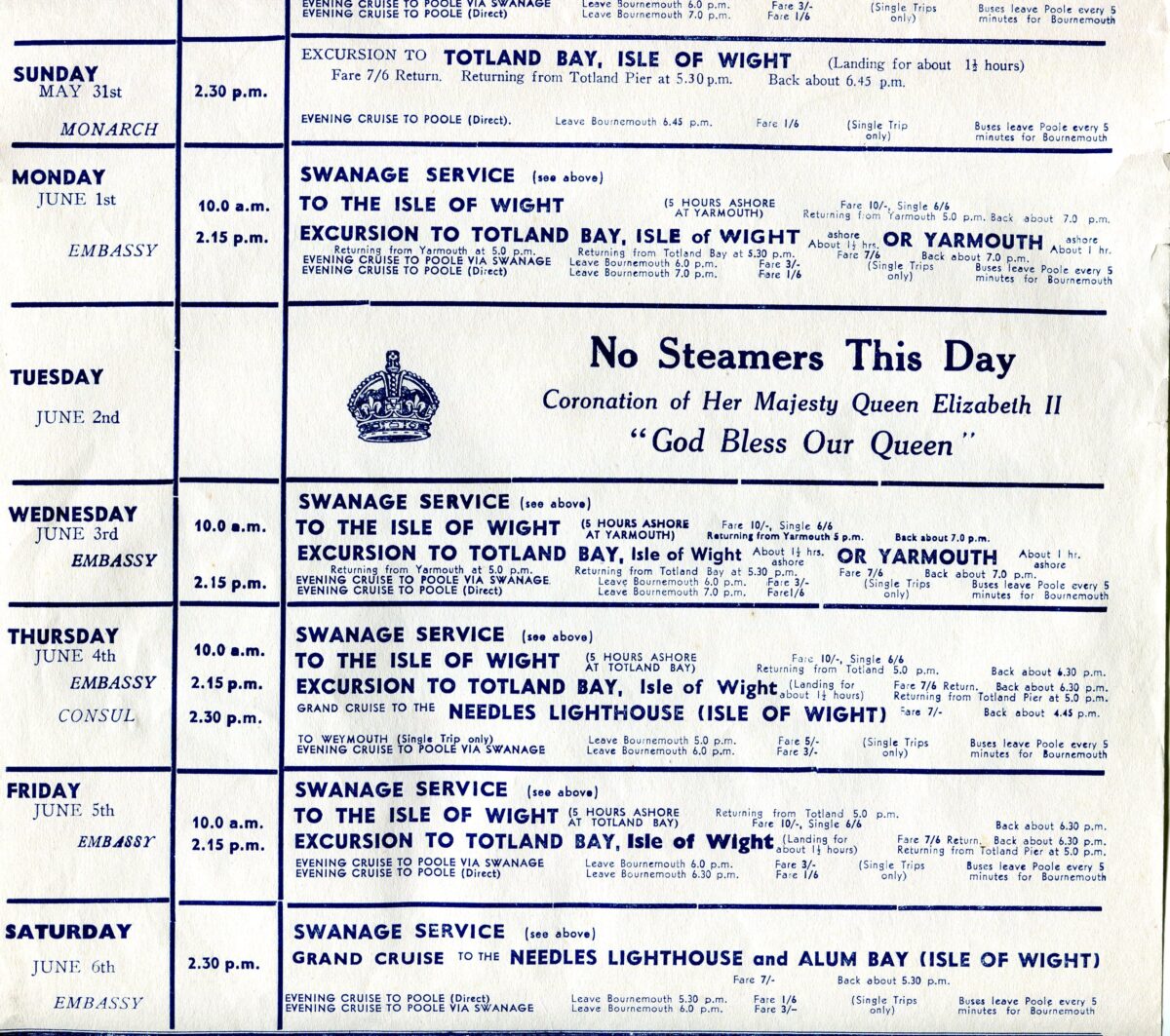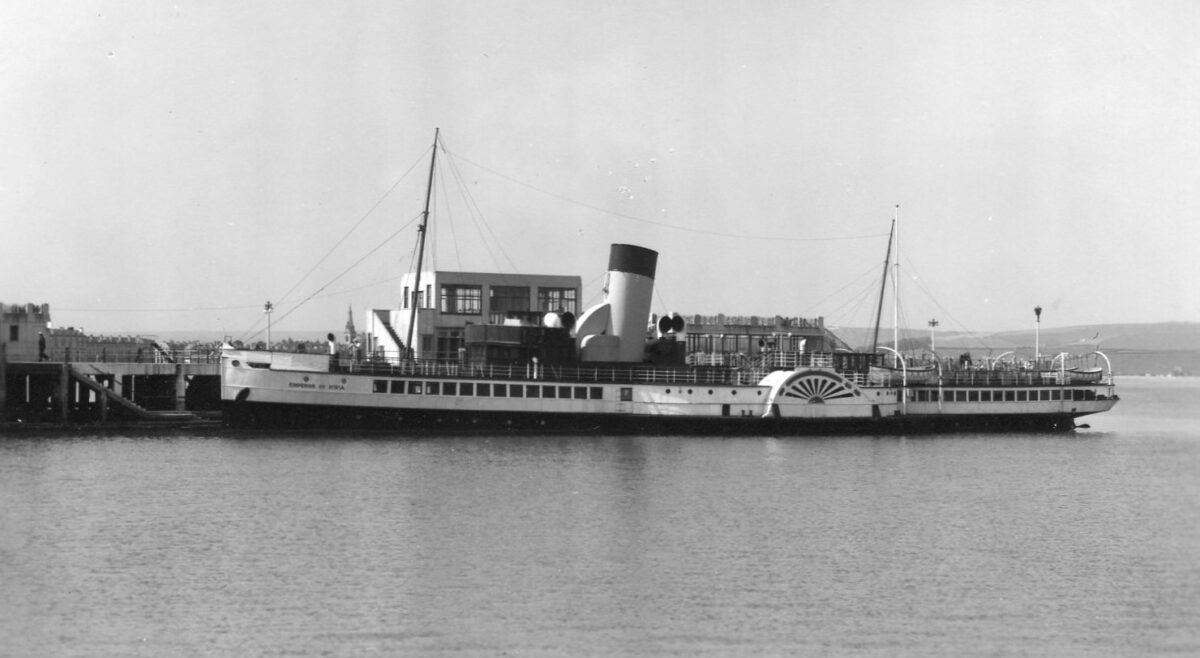
By the middle of May 1953 Embassy was back in service running predominantly from Bournemouth to Totland Bay and Yarmouth Isle of Wight.

Monarch was on the Bournemouth/Swanage service.

They were joined by Consul on Tuesday 26th May up from Weymouth for a 2.30pm departure for a “Grand Cruise To The Needles Lighthouse (Isle of Wight) back 4.45pm before making off back home.

This pattern continued into the first week of June with no sailings at all advertised for Tuesday June 2nd, the day of the Coronation of Queen Elizabeth II. Cosens recognised the market. They knew that there was no point in running paddle steamer trips that day with the nation at large focusing on this special event with many glued to their relatively new fangled and in most cases recently acquired television sets.

Emperor of India was scheduled to make her first appearance of the season with a double run from Bournemouth to Totland Bay on Tuesday 9th June at 10am and 2.15pm
Then as June progressed Cosens had a windfall with the Coronation Naval Review at Spithead providing wonderful charter opportunities for their ships. From Thursday 11th June up to Sunday 14th all the Bournemouth steamers were away running in the Solent except for Emperor which held the fort alone.

On Thursday 11th and Friday 12th she ran her now usual 10am departure from Bournemouth for Totland Bay with an extension for a “Special Cruise Round the Fleet assembling for the Royal Naval Review at Spithead” “due back 6.30pm. On Saturday 18th she was scheduled to run to Spithead away at 9am and not back until 9pm. And on Sunday 14th was rostered for a 10am departure for a “Special Marine Attraction” to Spithead due back 6pm. On this trip, which was expected to be the busiest of all, the steamer notice declared “Complimentary and free passes not available. This cruise will be by ticket only which must be obtained in advance.” On the day of the Review itself Emperor too was away on charter leaving no service from Bournemouth whatsoever.

One unexpected interloper in this week offering a sailing from Bournemouth Pier was P & A Campbell’s Bristol Queen. She was in the vicinity for a charter from Southampton on the day of the Review and so advertised a special sailing away from Bournemouth to Spithead at 1.30pm on Saturday 13th which was marketed in Bristol with a combined steamer and railway fare.
On Tuesday 18th Embassy returned from the Review in time to take up the Swanage service from 2.30pm and Emperor for a 2.30pm departure for the afternoon cruise to Totland Bay back 6.45pm. The following day the Bournemouth services returned to normal.
For the rest of June Emperor, Embassy and Monarch were scheduled to run on Sundays, Tuesdays, Wednesdays and Thursdays with just two of them in operation on Mondays, Fridays and Saturdays with each steamer therefore being able to have a day off in turn.
The basic format for the Swanage service was to run seven days a week with departures from Bournemouth at 10.30am (not Sundays), 2.30pm, 4.15pm and 6pm with an extra departure at 12.15pm from Monday 29th. Monarch took all these trips on days of three steamer operations and in her turn on the roster on the other days.
Emperor was the mainstay of the Bournemouth to Totland Bay or Yarmouth three hour round trips with departures at 2.15pm on Sundays and Fridays and at 10am and 2.15 on Mondays, Tuesdays, Wednesdays and Thursdays.
Embassy had a more varied roster this June being scheduled for the 2.15pm departure for Totland Bay on Saturdays, the 2.30pm “Grand Channel Cruise along the beautiful Dorset Coast towards (note towards rather than to) Lulworth Cove” on Sundays and longer day trips on Tuesdays, Wednesdays and Thursdays of which in June she offered seven to view the liners in Southampton Docks, one to Southsea and one to Ventnor and Shanklin..
Consul came up with passengers from Weymouth on Tuesdays June 9th and 23rd to offer a 2.30pm “Grand Cruise to The Needles Lighthouse and on Thursday 18th for a 2.30pm “Cruise to Brownsea Island” back 4.30pm. Later in the season she used some these visits to Bournemouth to add extra capacity on the Swanage service.

I love looking at the commercial side of paddle steamer operations. What worked. What didn’t work. What produced the best revenue per hour steamed. What didn’t. And so on. And at Bournemouth it is clear that there were two honeypot routes. The first was the Bournemouth/Swanage service which ran day in day out throughout the season packing in the punters. With a steaming time of 45 minutes each way it was not a very exciting schedule I give you but it was one which consistently carried passengers and took in money.
The second was the Bournemouth to Totland Bay or Yarmouth three hour round trip out in the morning and back in the afternoon or round trip in the afternoon all of which ran every day. When the going was good this really could pack in the passengers. The morning trip also connected with a “Combined Steamer and Motor Coach Tour of the Isle of Wight” Mondays to Fridays each week. They were very popular. It was not uncommon even into the mid 1960s for five or six coaches to await the steamers’ arrival at 11.30am to carry their passengers around the Isle of Wight by road. Indeed they were far more popular with the general holiday making public than longer day trips round the Isle of Wight by sea ever were. In 1953 Cosens scheduled just three of the latter during the season. They scheduled the combined steamer and motor coach tours of the IOW five days a week, each and every week, throughout the season. That speaks for itself. And it had the commercial bonus of enabling Cosens to charge a day trip fare for a trip which involved only an hour and a half steaming out and an hour and a half steaming back. Kerching……!
Then there were the longer day trips to more exotic destinations almost always taken during the summer of 1953 by Embassy which was smaller and more economical to run than Emperor per hour steamed. Far and away the most popular were those to view the liners in Southampton Docks including Queen Mary, Queen Elizabeth or the United States. They were scheduled for thirty Tuesdays, Wednesdays and Thursdays throughout the summer. And all of them also called at Totland Bay or Yarmouth on the return leg for an hour ashore around 4pm thereby positioning Embassy to be able to boost capacity and help the Emperor shift the crowds on the shorter homeward run of the honeypot route back to Bournemouth And remember that Emperor had generally made two trips across from Bournemouth so any spare capacity on Embassy was sometimes needed to get all the passengers back home at really busy times.
Ten were offered on the generally quieter Fridays to Lulworth Cove with Embassy’s passengers transferring to Consul at Swanage and Consul’s passengers from Weymouth transferring to Embassy for the run across to Totland Bay direct.
Four were rostered to Weymouth with a trip round Portland Harbour, three to sail around the Isle of Wight and just one each to Southsea and Ryde

The reopening of Ventnor Pier in 1953 might have been thought to have added an additional and successful day trip opportunity but I am not sure that the evidence is there to support that. After the first such trip on 26th June, three more were scheduled up to 23rd July after which there was a gap of a month before they reappear once again in the steamer notices. That suggests to me that they weren’t commercially that great. If they were packing in the revenue then why cut them from the timetable for so long and in the peak weeks? It was not until late August that they reappear for two more sailings only maybe as a result of the owners of Ventnor Pier asking (begging?) for more calls. But even so that only adds up to a total of six trips all season. Also Bournemouth to Ventnor direct was not a very scenic trip with the course taking Embassy at least two miles offshore along the SW coast of the IOW for much of the way. And if there was a breeze it would not have been a comfortable ride for the passengers. The outward bound course is 115 degrees and the return 295 degrees which would have put Embassy pretty much broadside on to any swell conjured up by the prevailing SW wind leading to a little bit of rolly-poly and the consequent need to swing the seasick mop and bucket into action.
Adding all these together makes a total of just fifty two longer day trips sailing outside the golden triangle connecting Swanage, Bournemouth and the piers at Totland Bay or Yarmouth at the western end of the Isle of Wight in the 140 or so operating days of the 1953 season. Contrast that with the two honeypot routes. That summer there were more than 400 round trips scheduled between Bournemouth and Swanage and 250 between Bournemouth and Totland Bay or Yarmouth.
The economics also favoured the golden triangle as the best revenue generator. The fare for the one and a half hour return trip between Bournemouth and Swanage was 4/6 which comes in at 3/- per hour steamed. The fare for the three hour return trip between Bournemouth and Totland Bay or Yarmouth was 10/- which comes in at 3/6 per hour steamed. The day trip fares were 13/6 for up to nine hours steaming which comes in at 1/6 per hour steamed.
Emperor was first to finish making her usual two round trips from Bournemouth to Totland Bay on Friday 11th September. Monarch continued on the Swanage service up to and including Friday 25th September. And Embassy carried on during the following week up to Thursday 1st October after which she joined her consorts to lay up for the winter in Weymouth.
So how was the 1953 season commercially overall? The Directors’ Report for Cosens AGM for the year ending 31st December 1953 states “The Royal Naval Review at Spithead was a source of increased revenue to the Company but the counter attractions of the Coronation celebrations in London and the bad weather in July materially reduced steamer earnings. On the whole, however, 1953 was better than the two previous seasons. The works department was fully engaged during the year, mostly on Government work, and new machinery which has been installed will enable different classes of work to be undertaken. The Cold Storage department is still controlled by the Ministry of Food but it is expected to revert to the Company this year when food rationing ends”.
Cosens ever had other strings to their bow. They had a good commercial eye for what worked and for what didn’t work. They knew how to diversify. And their solvency as a company was never solely dependent on how well or badly their excursion steamer services fared.
Kingswear Castle returned to service in 2023 after the first part of a major rebuild which is designed to set her up for the next 25 years running on the River Dart. The Paddle Steamer Kingswear Castle Trust is now fund raising for the second phase of the rebuild. You can read more about the rebuilds and how you can help if you can here.
John Megoran


